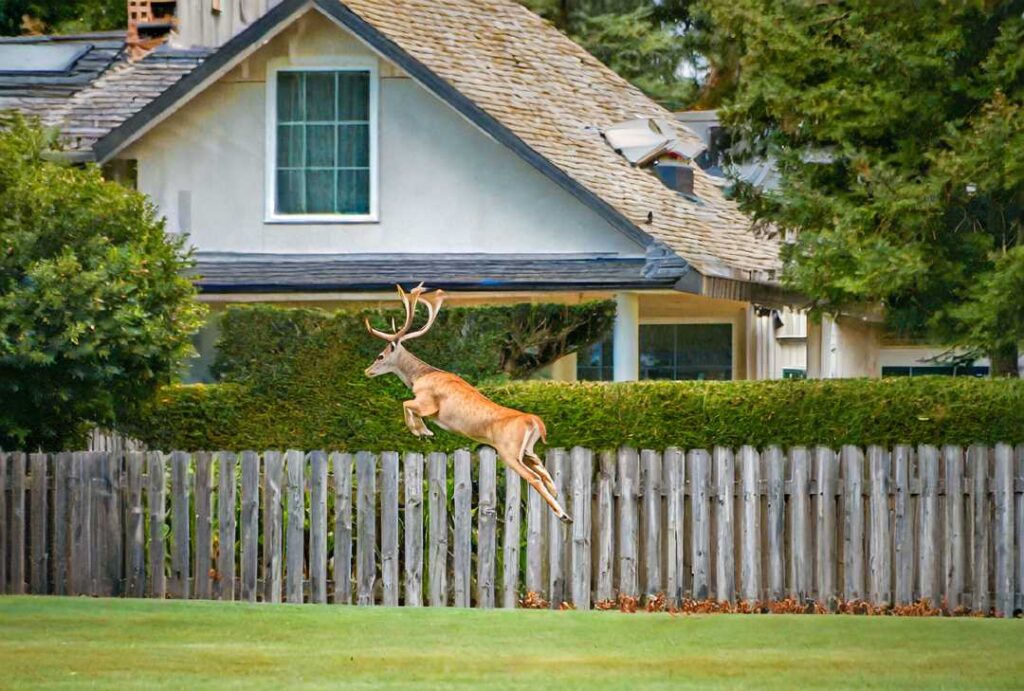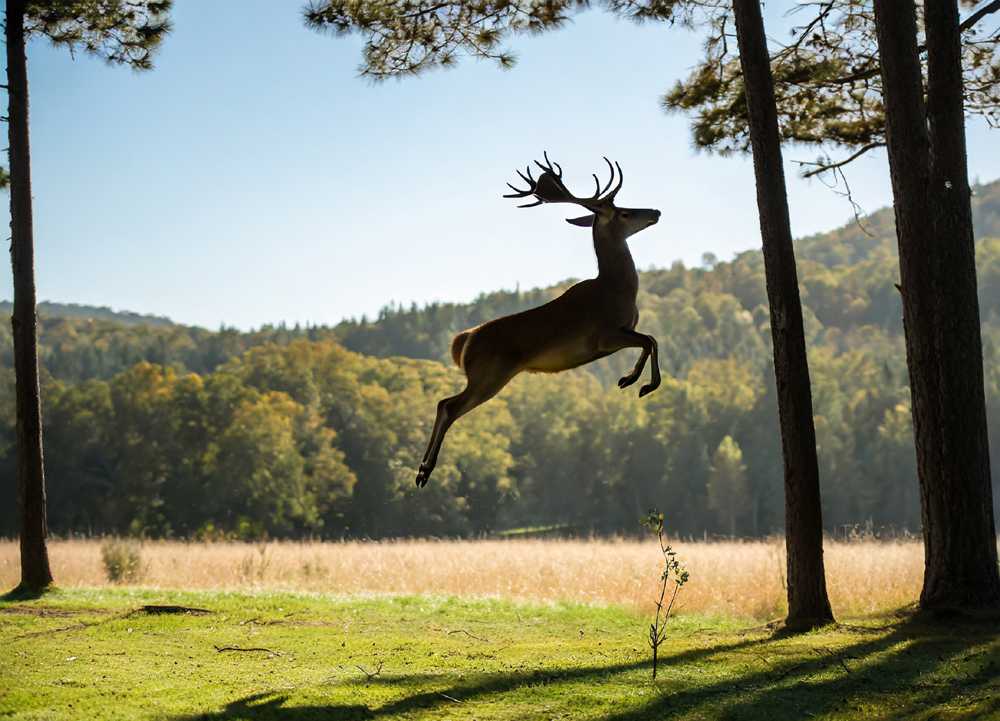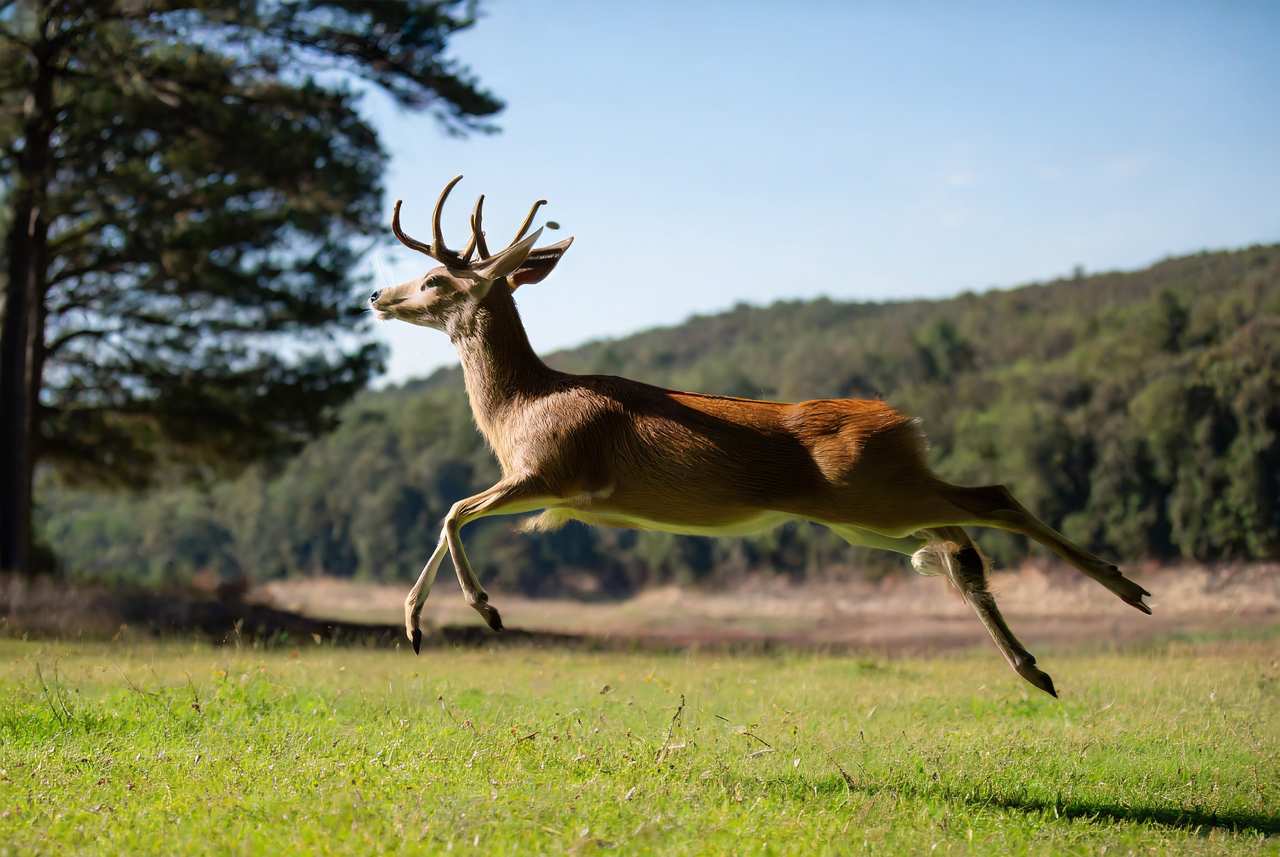Amazingly agile, deer can jump over barriers and move across difficult terrain with ease. Deer defy gravity with 8-foot (2.4 meters) leaps, some soaring past 10-foot (3 meters). Age, size, and species sculpt this biomechanical feat, propelling them over obstacles and terrain with breathtaking agility.
Deer Jumping Heights by Species
| Deer Species | Average Jump Height (feet) | Maximum Jump Height (feet) |
|---|---|---|
| White-tailed Deer | 7-8 | 10-12 |
| Mule Deer | 8-9 | 12-14 |
| Black to tailed Deer | 7-8 | 10-12 |
| Fallow Deer | 6-7 | 9-10 |
| Sika Deer | 6-7 | 9-10 |
| Red Deer | 7-8 | 10-12 |
| Axis Deer | 5-6 | 7-8 |
| Wapiti (Elk) | 7-8 | 10-12 |
| Roe Deer | 5-6 | 8-9 |
| Chital Deer | 5-6 | 8-9 |
| Muntjac Deer | 4-5 | 7-8 |
| Caribou | 5-6 | 8-9 |
| Elk | 7-8 | 10-12 |
Impressive leaping skills
Vertical Leap:
- Average Height: The common White-tailed deer found in North America can jump 8 to 10 feet, but some of them can jump up to 12 feet in a single bound.
- Factors influencing height: The vertical leap of a deer is affected by a number of factors, such as its species, size, age, and general physical state. Higher leaps are often seen in younger and healthier individuals, and there are clear distinctions across species—mule deer, for example, are better jumpers than white-tailed deer.
Horizontal Leap:
- Distance Achieved: Deer have exceptional horizontal jumping skills; they can leap an average of 20 to 30 feet in a single bound. Notably, reports of deer crossing unusual lengths of up to 40 feet have been made.
- Factors influencing distance: A deer’s horizontal leap is impacted by its species, size, and velocity, much as its vertical leaps. Running speed is a crucial factor since more speed translates into more force for the leap.
Deer jumping over a fence
Different deer species have varying capacities to jump fences:
- White-tailed Deer: The most common deer in North America, white-tailed deer can jump up to 8 feet (2.4 meters) vertically and 20 feet (6 meters) horizontally.
- Mule Deer: Found in western North America, mule deer are somewhat bigger than white-tailed deer and can jump 25 feet (7.6 meters) horizontally and 9 feet (2.7 meters) vertically.

- Fallow Deer: Native to both Europe and Asia, fallow deer are smaller than white-tailed deer and can jump up to 15 feet (4.6 meters) horizontally and 7 feet (2.1 meters) vertically.
- Red Deer: The biggest species of deer in Asia and Europe, red deer can jump up to 8 feet (2.4 meters) vertically and 28 feet (8.5 meters) horizontally.
Beyond the Numbers:
It’s important to remember that these are just average figures. Deer are incredibly adaptable and resourceful animals, and their jumping abilities can vary greatly depending on the situation. They might jump higher to escape predators, clear obstacles like fences or streams, or reach desirable food sources.
- Landing gracefully: Deer possess strong legs and flexible hooves that allow them to absorb the impact of landing from high jumps.
- Not just jumping: Besides jumping, deer are also skilled climbers and can navigate steep terrain with ease.
- Survival instinct: Their jumping ability plays a crucial role in their survival, helping them avoid danger and thrive in their natural habitat.
Influential Factors on Deer’s Leaping Skills
- Muscles: Strong hind legs and powerful back muscles provide the necessary force for propulsion.
- Flexibility: Deer have a flexible spine and joints that allow them to extend their bodies and limbs for greater reach.
- Balance: Excellent balance and coordination are crucial for landing safely after a jump.
- Motivation: Deer typically jump to escape predators, reach food or water, or navigate obstacles. When startled or threatened, they may jump over fences or other barriers.

Factors Affecting Leap Height:
- Species Dynamics: Different species of deer have unique leaping skills. Mule deer, which are abundant in western environments, are particularly good jumpers because their legs are stronger than those of white-tailed deer.
- Age and Stature: Deer’s agility is sometimes a result of their young and diminutive size. Compared to their older and bigger counterparts, younger and more petite persons often have better levels of agility, which translates into higher capacity for leaping.
- Physical Agility: A deer’s ability to leap is closely related to its physical health. A healthy, well-muscled deer jumps higher than one that is underweight or injured.
- Terrain Dynamics: The way that approach and terrain interact affects leap height greatly. Deer use the terrain to their advantage by jumping higher while going downhill or taking advantage of the uneven surfaces. The stage of nature transforms into a dynamic arena where every leap is a choreographed and flexible performance.
Exploring Deer Anatomy and Muscle Structure
| Anatomical Feature | Role in Jumping |
|---|---|
| Powerful Hind Legs | Enable explosive propulsion, allowing deer to launch themselves into the air |
| Flexible Spine | Provides the necessary range of motion, enabling efficient leaps and mid-air adjustments |
| Long Legs | Afford increased stride length, aiding in covering long distances in a single leap |
| Strong Ligaments and Tendons | Provide stability and elasticity, ensuring the support and recoil needed for powerful jumps |
Frequently Asked Questions
How far can an adult deer leap on average?
White-tailed deer and other healthy adult deer are often able to leap up to 8 feet (2.4 meters) in a single bound. There have been reports of some really remarkable people clearing as high as 10 feet (3 meters)!
Are deer limited to vertical jumps?
No, deer are also skilled at horizontal leaps. They can go 20–30 feet (6–9 meters) in a single bound with ease, and some have even been seen to traverse 40 feet (12 meters)!
Can fences effectively deter deer?
Since most deer are unable to cross fences higher than eight feet (2.4 meters) in a single bound, these fences are usually effective deterrents. It’s crucial to keep in mind, however, that deer are sly animals and could still try to climb a fence or find another way around it, particularly if they’re driven by fear or hunger.
Conclusion
While deer are impressive jumpers, it’s important to remember that they are not invincible. Fences taller than 8 feet (2.4 meters) are generally effective deterrents, and deer can be injured or even killed if they attempt to jump over obstacles that are too high or too challenging.
So, the next time you see a deer, take a moment to appreciate its impressive jumping ability! These graceful creatures are masters of navigating their environment, and their agility is a key part of their survival strategy.
- California Deer Hunting Guide: Seasons, Rules, Permits, and More - 26 June 2024
- Arkansas Deer Season 2024 [Schedules, Licenses, Bag Limits & More!] - 26 June 2024
- 2024 Arizona Deer Season New Dates & Rules! - 25 June 2024




